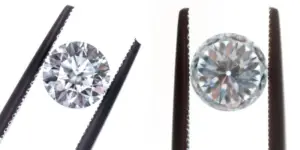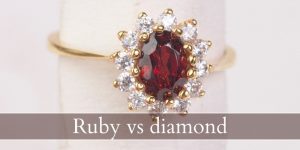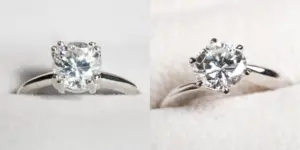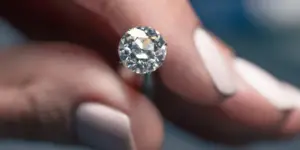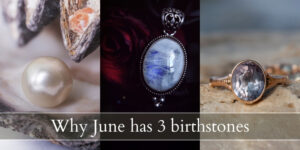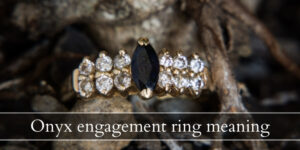Rubies and pink sapphires have caused a bit of a debate n the gemstone world, mostly because people don’t seem to agree where to draw the line between the two gems. Both are beautiful in their own way, but how do you separate one from them other ?
Today we’re taking a look at pink sapphire vs ruby and helping you understand just why it’s so difficult to separate them.
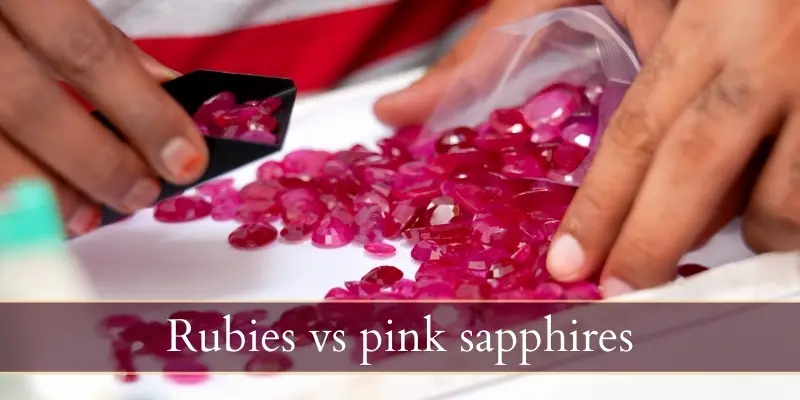
Pink sapphire vs ruby
Pink sapphires have a noticeable purple tint to them, as they have less chromium than rubies. This means the titanium and iron trace elements bring out a bit more blue in a pink sapphire and give it a pink instead of light red coloration.
Pink sapphires are corundum that has less chromium than rubies, but also contains higher amounts of titanium and iron just like blue sapphires. This means the difference between a ruby and a pink sapphire is often very faint and subjective. Rubies are far more expensive than pink sapphires, and they come with the prestige of a well known, ancient gemstone while pink sapphires are less known and come as a surprise for most people.
In short, the man difference between rubies and pink sapphires is the dominant red color. Corundum with a dominant red (the most chromium) will be classed as a ruby, while one with less chromium and larger amounts of titanium and iron will be classed as a pink sapphire. This difference is easier to see when looking at two gems together for a better comparison in hue.
Read also: Black Diamond VS Onyx
However, color is a very subjective thing. One person’s cool-toned pink may be another’s neutral-toned pink. To one gemologist a very fine ruby with a very slight pink hue might still class as a ruby, while for another it may slide into pink sapphire territory. So the trouble is largely in the eyes perceiving the gem, and this also affects the price.
Rubies tend to be a deeper red than pink sapphires
Pink sapphires and rubies are the same thing – corundum, but rubies have a dominant red hue given by high amounts of chromium, while pink sapphires have chromium for red/pink, but also titanium and iron for blue. The most sought-after ruby color is pigeon’s blood, a very deep, saturated red. This is a color that is very rare, and you have almost no chance of finding this color in a rough, natural ruby.
Most pigeon’s blood rubies are regular rubies that have an enhanced color, resulting in a deep red. Like sapphires, rubies go through treatments for color and clarity. This deep red color is what most people associate with rubies, and for good reason. It’s the go-to red gemstone so you expect it to be a bright, saturated red.
But rubies come in different color intensities, and the paler ones (pinkish) are incredibly hard to tell apart from pink sapphires. When shopping for rubies you will always be presented with the better color ones first. So you will almost always only see the red ones.
Pink sapphires are usually light enough to not be immediately confused with red rubies. Often the pink sapphires you see are treated for better color, in that the purple/blue hues are removed by a heat treatment. This treatment also improves clarity.
But when you compare a lighter ruby with a pink sapphire ? To your eyes they may appear like the same gem, but to a jeweler with the right equipment the difference should be visible in how much blue tone there is.
Pink sapphires are cheaper than rubies
We said earlier that how the corundum is classed affects its price. This is because pink sapphires are more affordable than rubies, and for the really hard to discern gems like a very deep pink sapphire, the right certificate can land it in ruby territory and get it a far higher price. How much higher ? Here’s a few examples.
A fine quality ruby with a deep, vivid red and eye-clean clarity sells for an average of $80,000 per carat. A paler ruby that could easily fool someone into thinking it’s a pink sapphire usually sells for an average of $7,200 per carat for an eye-clean gemstone.
For comparison a vivid pink sapphire with a purplish and eye-clean clarity sells for an average of $8,000 per carat. Paler gems sell for far less, an average of $2,000 per carat for very pale pink sapphires. The cheapest ones sell for an average of $300 per carat, with varying degrees of intensity but what drives the price down is the presence of inclusions you can see with the naked eye, and color enhancements.
Rubies are rarer than pink sapphires
One thing to not is the rarity of each gemstone. while both pink sapphires and rubies are corundum, rubies occur much less in nature than pink sapphires. This is because corundum rarely has enough chromium in it to classify as a ruby and get a deep red color.
Or, another way to look at things is that rubies make up only a small percentage of the total corundum family, the other sapphire colors make up the rest. This doesn’t mean you will have a hard time getting you hands on a ruby. But it’s part of why rubies are so expensive compared to pink sapphires.
Can you use pink sapphires instead of rubies ?
You can use a pink sapphire instead of a ruby, but only if the ruby your are replacing is a pale ruby. One that appears as a light red/pink color. A pink sapphire can never replace a deep red ruby, but it can work very well for lower end rubies.
Both rubies and pink sapphires have the same hardness (9 on Mohs scale) because they are the same material. This means you can easily wear your pink sapphire or ruby in a ring or bracelet, every day.

I’m the main author for jewelrymaterialguide.com. I started this site after we did tons of research before our wedding and noticed that there is information about rings, jewelry, and so on that is really hard to find on the internet.

